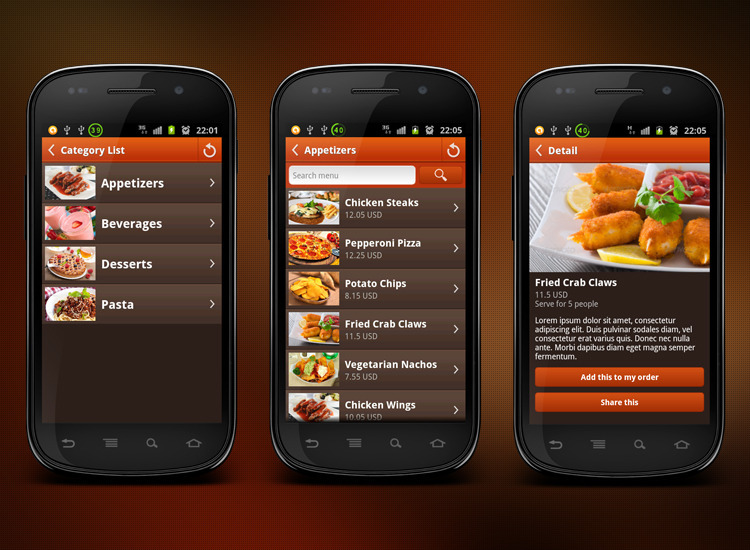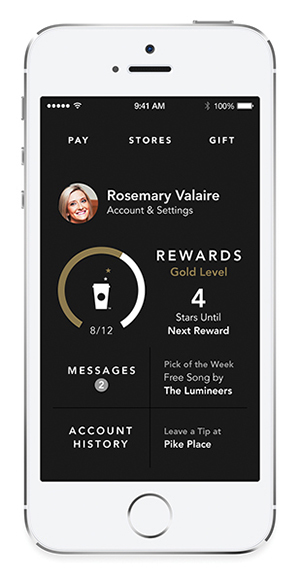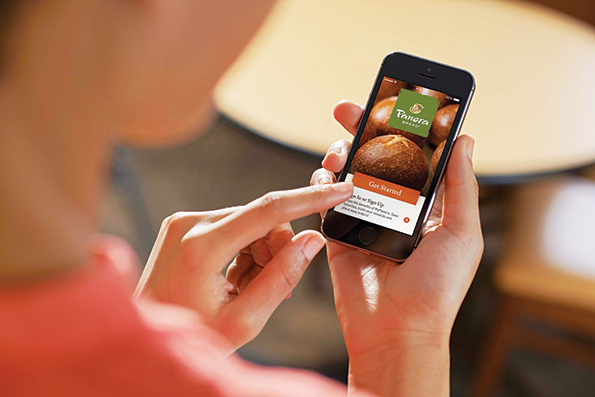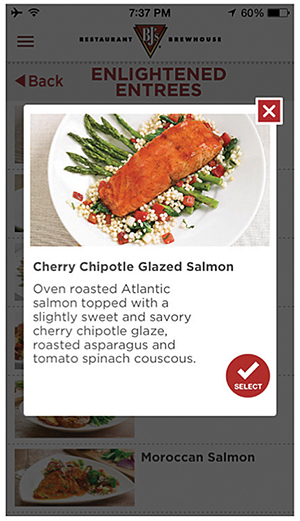Mobile applications of restaurants: What customers want

In our blog, we wrote about how restaurants automate work using special systems (for example, Jowi ), use psychological tricks to increase the average bill, and also take care of the comfort of visitors using the right light and sound .
In addition, the number of establishments that develop their own mobile applications is constantly increasing. Why are they needed, and what do users expect from such software? There was a time when the main function of restaurants ’mobile applications was to help customers find the nearest establishment and get acquainted with the menu. Now it is not so, journalists write the edition of the Restaurant News.
')
Due to the fact that many restaurant chains are introducing digital / mobile technologies into their work, customers now have a wider range of services.
Thanks to technical innovations, restaurants can allow visitors to pre-order, pay for it and avoid a long line. And customers can order the desired dish with delivery. They can also order and send gift cards, study the nutritional properties of selected dishes, track their loyalty bonuses, and sometimes even play games.
However, not all consumers want to fill their smartphones with applications of individual restaurants.
A study conducted this year by OpenTable showed that 56 percent of respondents chose “no rather than yes” and “no” options to offer to download the application for a particular restaurant, and only 6 percent gave a positive answer.
Respondents indicated that they would prefer to install an application that contains information about several restaurants at once .
According to the official joint report by the National Association of Restaurants and the mobile operator LevelUp, different types of users need different technologies, but a number of universal functions can be identified that are now beginning to gain popularity.
The opinion of the leading players about their digital campaigns once again proves that the implementation of certain functions can significantly increase sales and the flow of customers.
Below is an overview of some of these features:
Pre-order payment

Using the Starbucks mobile application, you can place an order and pay for it.
Seattle-based coffee shop chain Starbucks has become the absolute leader in introducing innovative digital / mobile technologies. In December of this year, the corporation launched a mobile application that allows you to pre-order drinks and food in several coffee shops in Portland, Oregon. After that, the trend has widened throughout the United States, and now the application is already available in all 7400 network establishments in the country. The success of the mobile application exceeded all expectations of the company. It allowed to significantly reduce the queues, speed up service and improve the efficiency of the institutions as a whole.
In July, company officials reported that processing and paying for orders via a mobile app accounted for 20 percent of all transactions, or about $ 9 million a week, and this is far from the limit, since the app is now available in densely populated cities like New York. Starbucks plans to add a delivery feature to its app next year.
During his presentation, David Tarantino, an analyst at Baird Equity Research research company, said: “We believe that Mobile Order and Pay [a smartphone service that allows you to place an order and pay it remotely ] can provide a significant increase in sales in the 2016 fiscal year relative to the past years, as well as a long-term advantage for Starbucks (by improving the quality of service, integration into the My Starbucks Rewards program), which will result in long-term sales growth (including by increasing the amount of receipt by the supply of additional goods) and accelerate the adoption of mobile technologies (which will serve as tools of personalized / dialog marketing). "
The updated business model of Panera Bread 2.0 also uses digital technologies, including a mobile application that allows customers to place and pay for the order in advance, and self-service terminals installed in the establishments with a touch screen. By the end of the fiscal year 2015, the company plans to transfer 400 out of 1,926 of its bakery cafes to model 2.0.

During a press conference in July, founder, chairman of the board of directors and CEO of the Panera network, Ron Shaich, reported that 10 percent of orders at network establishments were orders made using digital technologies — including mobile apps, websites and self-service terminals. This number is expected to increase as the company continues to implement version 2.0.
In those cafes where Panera Bread 2.0 has already been launched, the number of orders made using digital technology is more than 20 percent of the total, and up to 30 percent in establishments that switched to 2.0 more than a year ago, he said.
Sheich argues that the use of digital technology leads to a reduction in production costs and wages of employees.
“We are absolutely convinced that technology plays a crucial role in our multi-channel business model,” says Schaych. "At the moment, the percentage of orders made by our customers using digital technology is higher than that of any other restaurant chain, with the exception of pizzeria chains that have been involved in online commerce for several years."
According to a report by the National Restaurant Association of the United States and LevelUp, the pre-order feature, available on mobile apps or on restaurant websites, brings about 5 percent of sales in the first three months after integration.

Network of democratic restaurants BJ's was one of the first to launch a mobile application for processing and paying for orders
A LevelUp study shows that customers who place an order online visit restaurants 67 percent more often than others.
In 2014, the Taco Bell chain of fast-food restaurants launched the first of its kind mobile application for placing and paying for orders. To date, more than 3.5 million customers use this application, and, according to company representatives, it has received positive feedback.
In recent weeks, Jamba Juice, Firehouse Subs, and Papa Murphy's Take'n'Bake Pizza are among the restaurants that are planning or have already launched the application with the function of pre-ordering and payment.
Last year, the restaurant chain BJ's Restaurants Inc. one of the first to launch a mobile application that allows customers to make pre-orders not only for takeaway, but also if they dine in a restaurant.
The purpose of this innovation was to increase the speed of service. The ability to pay for orders through the application allowed visitors to leave the restaurant at any time, without waiting for the invoice.
So far, the application has not increased the flow of customers or sales, but the director of BJ's Greg Trojan (Greg Trojan) is sure that this will happen in the future.
“Such innovations change the way of thinking,” he said in an interview in July. “For now, not all people understand that they can have dinner at a restaurant by making a reservation. It’s more common for them to take takeaway, so for now the number of orders “with them” is more. ”
At the same time, he adds: “We like that others follow our example. If people get used to new technologies, they will begin to understand their benefits. ”
Delivery
For Starbucks, the next step is to introduce a delivery option into the application. This year, two types of delivery will be tested in the restaurant chain: Starbucks New York is leaning toward the Green Apron option, which provides for the delivery of Starbucks to the door by barists. Starbucks Seattle will begin cooperation with third-party delivery service Postmates.
The emergence of such third-party technology providers like Postmates has made it possible to make delivery from restaurants more affordable in a modern demand-based economy.
But such campaigns teach consumers to visit Postmates, DoorDash sites or mobile apps to decide on the choice of dish.
Many restaurants are concerned that they will lose the opportunity to lure customers to their own websites / mobile applications, and as a result of this they will lose the opportunity to receive information from such direct interaction.
In September, Olo's New York delivery service announced a new project called Dispatch that would solve this problem. The company plans to launch it in the fourth quarter of this year.
Noah Glass, founder and CEO of Olo, said that his service would allow large restaurant chains to offer delivery on a scale unavailable when working with third-party companies that currently cover a limited number of markets.
Dispatch will give customers the opportunity to use the application of a participating restaurant, make an order and pay for it in advance. At registration of the order the option "delivery" will be available. After that, customers can select the price and delivery time offered by local services, such as Postmates and DoorDash, and track delivery at each stage.
The order goes directly to the settlement terminal system. Olo is already cooperating with the largest companies engaged in the installation and maintenance of clearing terminals, what is its advantage over third-party delivery services.
In addition to the process of cooking, the work of such a restaurant operator does not require human participation. Dispatch will take into account that the preparation of a particular dish takes eight minutes, and the driver from the selected delivery service is five minutes drive to the client. Thus, by the arrival of the delivery man, the dish will be fresh and still hot.
The client, in turn, will be able to track the delivery in real time. Glass describes his delivery system as "Domino's Pizza tracker, only on steroids."
According to Glass, the main feature of the restaurant operator is direct access to information about the consumer who placed the order, in particular, to the history of his orders and contact information.
“Restaurants will not have to end relationships with their customers. Just now their customers will make orders through the app, ”he explained.
Glass believes that in today's economy, when consumers are obsessed with convenience, the delivery function is extremely important for every restaurant that uses digital technologies in their work. It is estimated that as a result of its integration, the number of orders increases by 80 - 100 percent.
Half of the orders of the largest pizza chains, such as Domino's, Papa John's and Pizza Hut, are done through digital devices.
Glass believes that by 2022, 50 percent of orders in the rest of the limited service establishments will also be carried out through digital devices. "The non-pizzeria market is $ 200 billion, which means we are talking about a shift of 100 billion," he said.
Loyalty program
Starbucks Chief Financial Officer Scott Mau (Scott Maw) suggested that the integration of the pre-order feature would lead to an increase in the number of My Starbucks Reward loyalty program participants.
And this, in turn, will allow the network to attract more customers through more developed targeted marketing.
In 2016, for example, the company will add to the application even more features that contribute to sales growth. For example, if a loyalty program participant orders iced tea, the application will automatically offer to add a panini or another dish to the order, based on previous orders from this customer.

This year, Taco Bell also plans to launch a loyalty program following the mobile app.
California-based restaurant chain Wienerschnitzel recently launched a mobile application that is tied to a loyalty program and allows you to pay for food with money that the user has previously deposited into his “account”. Customers can earn bonuses for every dollar spent and get a free set lunch. And on your birthday, you can get free kordog or sundae.
In addition, in the app, customers can watch the latest videos from the company and follow the news on social networks using the #Wienerschnitzel hashtag.
According to the report of the National Association of Restaurants and LevelUp, the functions of pre-ordering and payment help accelerate the pace of implementation / adoption of the loyalty program.
As a rule, only 5 to 12 percent of consumers accept a loyalty program. If the loyalty program is combined with mobile payments, their share increases to 18-28 percent. If you add a pre-order function to this combination, the figure rises to 15–35 percent.
The report also said that brands such as Starbucks and Dunkin 'Donuts found another hidden advantage of tying payment to loyalty cards. The fact is, consumers replenish their accounts with larger amounts, since it is much more profitable for them to place an order for $ 25 or $ 50 than to carry out small transactions with a high commission.
“However, it is worth noting that such loyalty programs are not suitable for every restaurant, so don’t be in a hurry to launch them in your business,” the report says. “Customers of these restaurants make orders every day, receiving bonuses for this, so it’s profitable for them to replenish the account of their mobile application.”
It is important to remember that the introduction of loyalty programs is associated with the likelihood of fraud and “cheating” on the part of the staff of the establishment - bonus cards, discounts and promotions usually create room for frauds on the part of staff and the uncontrolled award of prizes. To reduce this probability by using special tools. For example, in Jowi, we are implementing marketing strategies that allow a business owner to effectively attract new customers while protecting themselves from theft - the staff is not allowed to accrue bonuses, this is done automatically by the system. As a result, stocks work and make a profit, and additional control over employees is not needed.
McDonald's Digital Update
The McDonald’s fast-food restaurant chain began testing its mobile application last August, and since October it has become available throughout the United States. However, the company uses a deliberately modest approach to its promotion. At the moment, the McDonald's application is used primarily to search for nearby establishments, however, customers can also explore the nutritional properties of dishes, get coupons and discounts, and also become participants in the loyalty program and get a free drink by buying five drinks at McCafe.
During recent press conferences with Wall Street analysts, McDonald’s CEO Steve Easterbrook admitted that the company is a little behind in technological development, but he promised to correct the situation. It remains only to determine how the company will translate these plans into reality.
The McDonald’s development team “is already working hard to create new features that will speed up the transition from mass communication to personal interaction with customers in the future,” he said in July.
Easterbrook hinted at the possibility of introducing the function of pre-order, as well as the use of geolocation technology that can recognize guests on the McDrive strip before they make an order.
The entire restaurant industry will oversee the implementation of technological innovation in McDonald’s. It is obvious that Easterbrook considers digital functions as a way to meet the needs of consumers.
Source: https://habr.com/ru/post/368731/
All Articles